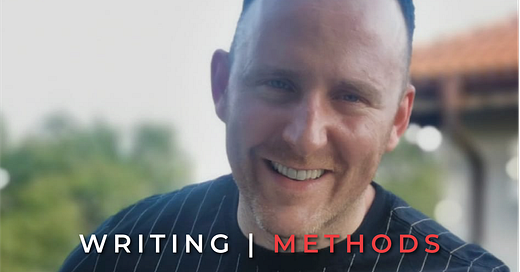Building Stories & Foregoing Rules: Stephen Duffy’s Writing Process
How a Horror Writer Balances Inspiration, Distractions, and Creative Freedom
Hey, welcome to Methods—the series where we explore the creative habits of fellow Substack writers.
Today’s feature is Stephen Duffy, a writer from Glasgow, Scotland.
He’s the author of Short Shivers, where he shares horror, thriller, and dark comedy stories, plus funny reviews of classic horror movies.
Check out his story The Birthday Wish
He also writes (Not a) Writing Expert, giving quick and helpful writing tips. His goal is to build a small, supportive community where writers can learn from each other. Take a look at his article
Take a look at his article How to Start Writing Part 1: Tips for Total Beginners
In this interview, Stephen shares how he finds ideas and plans out his stories, his favorite times and places to write, and some tricks he uses to get started when distractions get in the way.
Hope you enjoy it!
Know someone with a unique creative process? Drop their name in the comments—I’d love to feature them!
Creative Flow and Routine
I don’t really have a set routine! I do spend a lot of time thinking about ideas for stories or twists I can add to make things more exciting, though. Coming up with the ideas is the easy part — even fleshing out a plan is fairly straightforward. Actually writing them, though? That’s a bit of a slog!
Ideal Time to Write
Early afternoon is my ideal time to write — if the kids aren’t making too much noise, I can write pretty much anywhere, any time.
See also: How Michael Macfadden Balances Teaching, Parenting, and Creativity
Handling Distractions
I’ve found a couple of things that help, though it’s different every day (pretty sure I’m undiagnosed ADHD). First, I accept that distractions will happen — the phone's getting checked every two minutes, and that’s just how it is. Second, before starting a scene, I take a minute to close my eyes and imagine it: the sights, sounds, smells, even the temperature. Once I can feel the scene, I’m usually good to go for a few minutes, enough to get the flow started.
Writing Environment and Tools
My workspace is either my desk in the bedroom, which doubles as my work-from-home spot, or the couch. Occasionally, I’ll even work while my wife watches TV — not ideal, but I think it’s been useful learning to write in less-than-ideal settings.
Just me and my laptop, really. Now and then, I’ll Google random things like “What time does the sun set on the East Coast in April?” But I don’t worry too much about technical details getting in the way of the story; they’re important, but it’s my story, so if I need the sun to set at noon, it’s going to!
Influences and Inspiration
Movies and TV shows are probably my biggest influences. Growing up, I watched a lot of movies that, let’s just say, probably weren’t for kids. But it was the ’90s! I like gritty stories, and horror’s been a more recent interest. I also love fantasy, so it’s all a bit of a mix. Alien, Dexter (both books and the show), Game of Thrones (books and show) have probably shaped my storytelling style the most. I’ll admit I’m more of a reluctant reader, though.
Evolving Process and Approach
I go with my gut a lot. Writing “rules” are great in theory, but there’s a point where they start to weigh you down. So I just write and worry about the rest later.
Refining the Creative Process
My process hasn’t changed much, but I’m better at it. Now, before diving in, I’ll make a rough outline of the story, leaving lots of room for creative twists. I also give extra thought to scenes with potential logistical issues — things that could trip me up, like “how can Person A be there when they were just supposed to be somewhere else?” I’ve jumped into projects without this before, and I wouldn’t recommend it.
Thanks Stephen!
If you enjoyed this peek into Stephen's writing life, be sure to support his work by following his publications Short Shivers and (Not a) Writing Expert.
Subscribe to Writers Are Weird
Access the full archiveDocumenting the creative process. Written by Sam Mas




